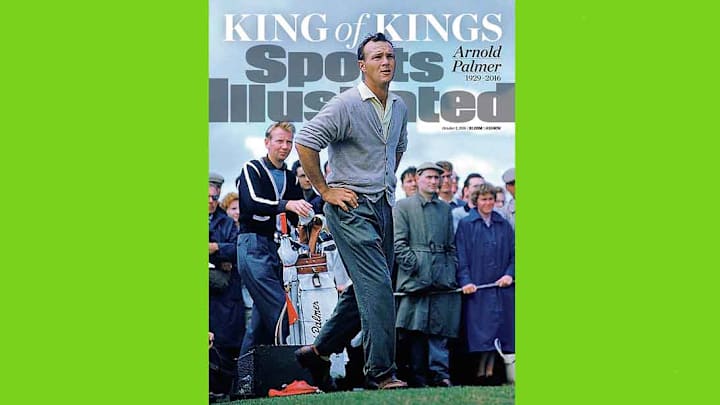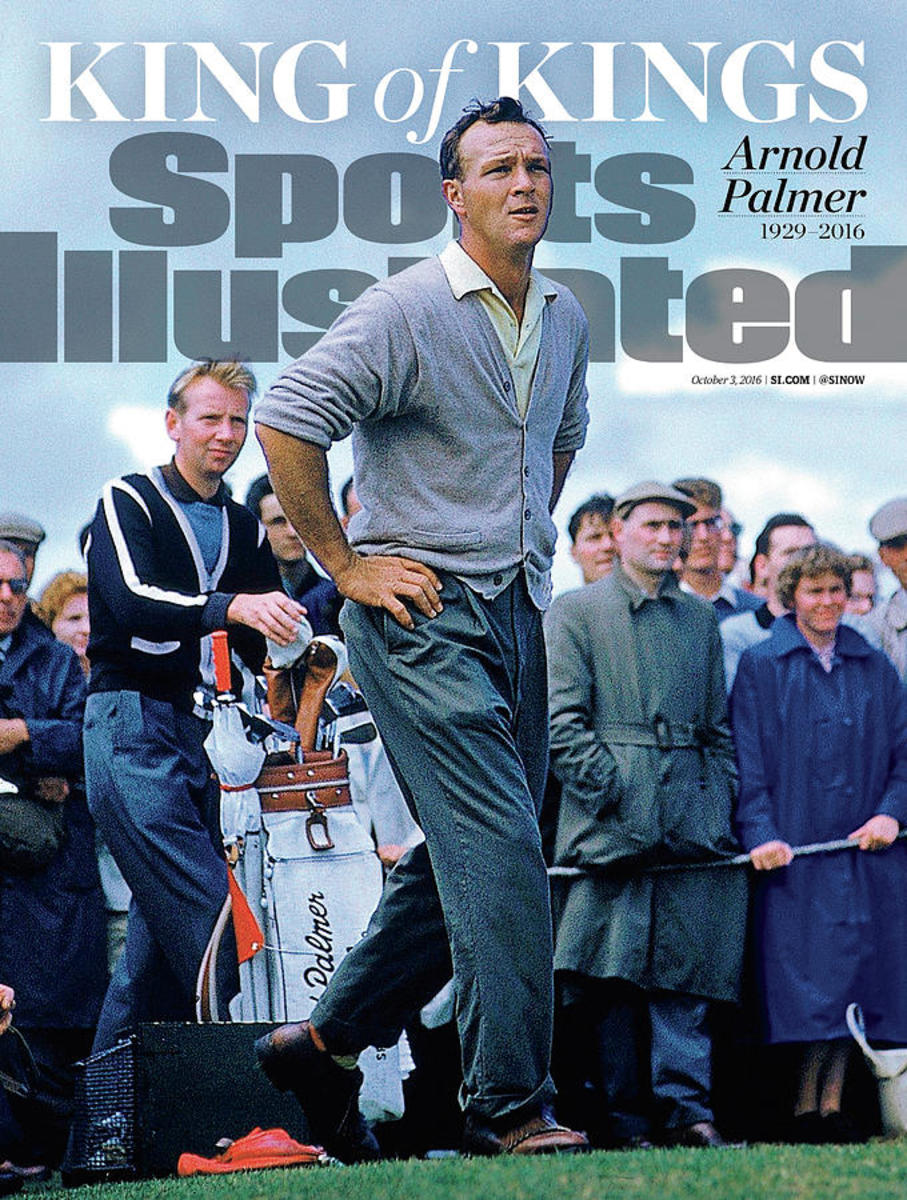Tiger, Jack, Arnie and Bobby Jones: Ranking the 10 Best British Opens at the Old Course

The British Open is holding its 150th tournament this week. The Open is so old that it started a year before the Civil War — the one between the North and the South, not the one between David Letterman and NBC. The Open even pre-dates the births of Clint Eastwood and Cher.
The Open has a storied rota in Scotland, England and Northern Ireland but no site has a richer history than the Old Course at St. Andrews. (Which reminds me, the Open is older than Julie Andrews, too.) The Old Course has hosted 29 Opens and this seems like an appropriate time to determine the 10 greatest Opens played in St. Andrews, especially since the editor told me to.
This week’s edition of The Ranking offers up the best Old Course Opens based on historical significance, notable feats, tense finishes, memorable moments and a complex algorithm called, “Because I feel like it.” Feel free to make your own list, then email it to yourself for validation …
10. J.H. Taylor, 1895 and 1900 (tie)
Britain’s so-called Great Triumvirate dominated golf around the turn of the century and it featured Taylor, James Braid and Harry Vardon. In ’95, the Open was played over two days (36 holes a day) and lengthened to 72 holes. Taylor posted the first score in the 70s at the Old Course. In 1900 Taylor held off his Triumvirate pals — crushed them, in fact — to win the third of his five Opens. Vardon finished second, eight shots back, while Braid was a distant third, 13 shots behind. Taylor closed with 75, then an Old Course record. Sizzle!
9. Zach Johnson, 2015
This was Jordan Spieth’s Open from the outset. The 21-year-old Texan had already won the Masters and U.S. Open. He chased his Grand Slam bid to all the way to the Old Course’s 72nd hole. When Spieth sank a long, electrifying birdie putt at the 16th, it appeared as if he might pull it off but he bogeyed the 17th hole, missed a birdie putt at 18 and missed a playoff. Instead, Johnson, Australian Marc Leishman and 2010 Open champion Louis Oosthuizen went to a tense four-hole shootout with Johnson prevailing. Bad weather forced two delays and the final round finished Monday. Rory McIlroy, the No. 1 player in the world, was the first defending champion in over six decades to miss the Open — he withdrew because he reportedly injured his ankle kicking a soccer ball with friends.
8. Jock Hutchison, 1921
Because no American had yet won the Open, Golf Illustrated magazine wrote to the PGA of America in 1920 suggesting a team of American pros be chosen to play the Open, expenses paid by funds the magazine raised from its readers. Eleven men sailed from New York on the RMS Aquitania in May, including Hutchison, a Scot who was a St. Andrews native but had gained American citizenship, Walter Hagen and Fred McLeod. Hutchison trailed by four after 54 holes but a closing 70 earned him a playoff against amateur Roger Wethered. Hutchison rolled to victory by nine, technically becoming the first American Open champion. Meanwhile, an impetuous young amateur named Bobby Jones made his Open debut and left in a huff, tearing up his card after taking four shots to escape a bunker at the 11th hole in the third round. Jones made critical comments about the course … but changed his tune a few years later.
7. James Braid, 1910
Ah, who can forget this old-school classic? Braid became the first man to win the Open Championship five times. He also was the first to break 300 for 72 holes. Well bowled, sir! Braid’s closing 76 helped him rally from two strokes behind George Duncan in the final round to win by four. It also helped that Duncan yo-yo’d to an 83. It was a memorable end to a week that began inauspiciously — a Tuesday cloudburst flooded the greens and caused all first-round scores to be washed out. Enter the “what-if” conspiracy theorists …
6. Bob Martin, 1876
Would you believe that tournament organizers forgot to book the course, causing Open competitors to play amidst paying public golfers? That led to backups on tees, long waits and a major rules controversy. David Strath, who’d pelted another golfer — an upholsterer — in the forehead with a shot in the second round, hit to the 17th green in the final round before the green cleared. His shot struck a public golfer who was putting. Strath tied Martin but observers claimed Strath’s shot at 17 would have gone well over the green and he benefited from his lack of etiquette. Club officials declined to issue a decision until after the playoff. Strath, outraged that they wouldn’t make a ruling before the 18-hole playoff, refused to take part. Martin, a master of the cleek (the ancient forerunner of the hybrid) and the run-up shot who disliked irons, simply “wandered over the course” in lieu of a playoff, according to the Edinburgh Evening News, and was awarded the Open title.
5. Seve Ballesteros, 1984
The 1977 Open, a battle between Jack Nicklaus and Tom Watson, was tabbed The Duel in the Sun. This Open, a duel between Watson and Ballesteros, could’ve been The War By The Shore. (Unless that’s already taken …) The two men waged a back-and-forth battle during the final round that culminated in a thrilling finish. After a well-placed tee shot at No. 17, the famed Road Hole, Watson missed the green long and right. His ball bounded across the road close to the wall. With a restricted backswing, Watson made bogey while up ahead on the 18th green, Ballesteros holed a 12-foot birdie putt that tantalizingly dropped in the side of the cup. He pumped his fist and legs repeatedly, a joyful celebration that never gets old when watched on video (except maybe in the Watson household). That two-shot swing gave the title to Ballesteros, who’d first won the Open in 1979.
4. Jack Nicklaus, 1970
This was actually a hell of a duel between Nicklaus and the colorful Doug Sanders, who never met a pastel sweater he didn’t like. Yes, this is the Doug Sanders Open. Sanders had a 3-footer for par at 18 to win the Open but bent over to wave a bug off his ball (or something). He then returned directly to his stance (instead of re-setting) and gaffed the putt. It’s still hard to watch. Sanders put up a terrific fight in the 18-hole playoff, however, and was tied with Nicklaus at the 18th tee. That’s when Jack peeled off his yellow sweater and crushed a drive that finished OVER the 18th green, a 360-yard blast done with a persimmon driver and a balata ball. Nicklaus chipped close, made his birdie putt to win by one and was so excited that he tossed his putter high in the air. It nearly took out Sanders on the way down. Sanders never won a major. The Nicklaus kid did all right.
3. Kel Nagle (and Arnold Palmer), 1960

The Open Championship was inconceivably not an important tournament to Americans in 1960. That changed when Arnold Palmer, the world’s most popular golfer, showed up to play after having already won the Masters and U.S. Open. Despite those wins, Palmer still had to tee it up in a 36-hole qualifier to get in the field. No wonder U.S. pros had quit coming over. Palmer was only one of four Americans in the field but 10 years later after Palmer’s appearance, there were 24. Americans officially fell in love with Palmer after his famous charge at Cherry Hills during the U.S. Open that summer. Palmer made another charge at the Old Course in the final round, including a birdie on the final hole that caused a roar heard by Nagle, facing a par putt at the 17th. Nagle, a little-known 39-year-old Australian, regrouped and holed that putt and parred the 18th to edge Palmer by one but Palmer’s run had done its job and captivated the public. Palmer went on to win the Open in 1961 and ’62 but it was his riveting loss in ’60 that resurrected American interest in this tradition-rich event.
2. Tiger Woods, 2000
Move along, people, nothing to see here. Only the modern game’s greatest player in the middle of his greatest year when he won four straight major championships. Looking back, Tiger’s superiority was almost laughable. He shot 19 under par, an Open record, a month after smashing U.S. Open scoring marks. He won by eight shots, posted all four rounds in the 60s and at 24 became the youngest to capture the career Grand Slam. In a footnote that paled in comparison to the victory, Tiger did not hit into a bunker for 72 holes. In two words: He good. The Tiger Woods Era was definitely on.
1. Bobby Jones, 1927
If there was any doubt about this being No. 1, the tiebreaker is Jones being carried off the green by a crowd of jubilant townsfolk. His love affair with the Old Course, after a rocky start, was cemented here. Jones asked the R&A to keep his Claret Jug in Scotland. His play for the week was sublime. He shot an opening 68, the first score in the 60’s in major championship history, and he sank an eagle putt at the fifth hole estimated to be 120 feet. He led by six strokes after the opening round and won by six to earn his second consecutive Open title. In 1958, St. Andrews named Jones a “Freeman of the City.” The only other American accorded the honor at that time? Benjamin Franklin, who was related to Tom Kite if I remember my eighth-grade history …
Reader feedback is encouraged at inbox@morningread.com and we may publish your letter (include your name and hometown). Click here to receive all the latest Morning Read news and commentary free in your inbox every morning.
